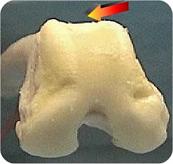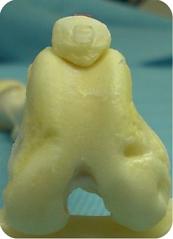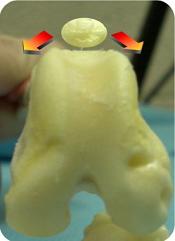Dislocating kneecaps or luxating patella can
be inherited, or acquired through trauma. It occurs in Toy Breed dogs
mainly but also can be found in larger breeds.
In dogs the patella is a small
bone which protects the front of the stifle joint (like our kneecap). It is
anchored in place by ligaments, and slides in a groove in the femur.
The Trochlear groove is not deep enough to keep the patella in place. If
this groove is not deep enough, the patella can "fall out" of it, causing the
luxation.
There are 4 grades of Patella
Luxation, those being:
|
GRADE 1 |
The knee is nearly normal and
the patella can only be dislocated if the knee is expanded and
digital pressure applied (in other words pushed off the joint). |
|
|
GRADE 2 |
The patella can be dislocated in
extension and remains out of place when the knee is flexed and
can be returned by manual pressure. Dogs with this grade
can be subject to a disease of the joint cartilage and secondary
osteo-arthritis due to the rubbing effect as the patella
constantly dislocates. |
|
|
GRADE 3 |
The patella is dislocated most of the
time. It can manually be put back into place when the leg
is extended, but it flips out easily again. Dogs
with this degree can also be a high risk of rupture of the
anterior cruciate ligament in the stifle (knee joint). |
|
|
GRADE 4 |
The patella is dislocated all of the
time and cannot be put back into place. The dog affected by this
grade exhibits lameness and an inability to walk and needs
surgical intervention. |
|
Cavaliers with Grade 3 and 4 usually require
surgery.
Normal V's Abnormal Patella
 |
NORMAL TROCHLEAR GROOVE.
The red arrow is showing the trochlear
groove. This is where the patella normally "rides".
This femur would be described as having a deep groove, which has
plenty of space to keep the patella where it belongs.
|
|
 |
ABNORMAL TROCHLEAR GROOVE.
The red arrow is pointing again to the
trochlear groove. Notice how shallow it looks. There is
not much space for the patella, and would be quite easy for the
patella to slip out or luxate. |
|
 |
NORMAL TROCHLEAR GROOVE WITH PATELLA.
This picture shows a normal trochlear
groove with the patella. Notice how the patella fits in
securely and is unlikely to fall out or luxate. |
|
 |
ABNORMAL TROCHLEAR GROOVE WITH PATELLA.
This picture shows an abnormal or
shallow trochlear groove. The patella has no groove to fit
into and can easily slip out to either side (see red
arrows). |
|
Clinical Signs of Luxating Patella
Clinical signs depend on the Grade of the luxation,
how long the dog has been affected and whether the dog has any additional health
problems.
Signs May Include:
* Mild intermittent rear leg lameness
* Inability to fully bend rear leg
* Hopping or skipping
* Kicking leg out behind dog
* Bowlegged or crouched position
* Reluctance to jump
OR THE DOG MAY SHOW NO SIGNS AT ALL!
Treatment and Prognosis
Surgery is most often required if the dog has a severe grade of patella
luxation (some grade 3's and all grade 4's). Occasionally if the dog is
overweight , placing the dog on a diet will ease the side effects as there is
less strain on the legs. The goal is to correct the bone defects that predispose
the patella to luxating.
The surgical technique is called Trochleoplasty. This surgical
operation deepens the trochlear groove, making it deeper so he patella is less
likely to slip out or luxate.
Another surgical technique veterinarians use is called Tibial Tubercle
Transposition. This procedure is used when the femur and tibia bones dont line
up quite right, which can lead to the luxation of the patella. A piece of
bone is cut from the tibia and moved, which helps to straighten the muscles
around the knee.
The prognosis for dogs with surgical treatment is good to excellent.
There is a 90-95% success rate, if the problem is detected and treated early.
A
VETERINARIAN DIAGNOSES LUXATING PATELLA.

Music:
How Am I Supposed To Live Without You - Michael Bolten
© Braydnvale Cavaliers 2004
